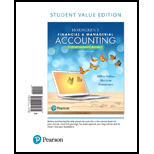
(1)
Transaction: The economic events which bring about any changes in the financial items of a business, and can be measured in the monetary units are referred to as transactions.
Accounting equation is expressed as shown below:
Income statement: The financial statement which reports revenues and expenses from business operations, and the result of those operations as net income or net loss for a particular time period is referred to as income statement.
Statement of
Return on Assets (ROA): This financial ratio evaluates how efficiently the assets are used in earning net income. So, ROA is a tool used to measure the performance of a company.
Formula of ROA:
To analyze: The transactions of CC Company, using the accounting equation in the given format
(2)
To prepare: Income statement of CC Company for the month ended November 30, 2018.
(3)
To prepare: Statement of retained earnings of CC Company for the month ended November 30, 2018.
(4)
To prepare: Balance sheet of CC Company on November 30, 2018.
(5)
To solve: ROA for CC Company for November 2018.
Want to see the full answer?
Check out a sample textbook solution
Chapter 1 Solutions
Horngren's Financial & Managerial Accounting, The Managerial Chapters, Student Value Edition Plus MyLab Accounting with Pearson eText -- Access Card Package (6th Edition)
- Financial Accounting Question need help with this accounting questionarrow_forwardFor the Crestview Manufacturing Company, the average age of accounts receivable is 50 days, the average age of accounts payable is 40 days, and the average age of inventory is 68 days. Assuming a 365-day year, what is the length of the firm's cash conversion cycle?arrow_forwardFinancial accountingarrow_forward
- Use this information to determine thearrow_forwardA California-based company had a raw materials inventory of $130,000 as of December 31, 2021, and $110,000 as of December 31, 2022. During 2022, the company purchased $175,000 of raw materials, incurred direct labor costs of $230,000, and incurred manufacturing overhead totaling $350,000. How much is the total manufacturing cost incurred by the company?arrow_forwardHello tutor solve this question accountingarrow_forward
- A company uses the weighted-average method for inventory costing. At the end of the period, 19,500 units were in the ending Work in Process inventory and are 100% complete for materials and 72% complete for conversion. The equivalent costs per unit are; materials, $2.75, and conversion $2.40. Compute the cost that would be assigned to the ending Work in Process inventory for the period.arrow_forwardAccounting problemarrow_forwardAccounting questionarrow_forward

 AccountingAccountingISBN:9781337272094Author:WARREN, Carl S., Reeve, James M., Duchac, Jonathan E.Publisher:Cengage Learning,
AccountingAccountingISBN:9781337272094Author:WARREN, Carl S., Reeve, James M., Duchac, Jonathan E.Publisher:Cengage Learning, Accounting Information SystemsAccountingISBN:9781337619202Author:Hall, James A.Publisher:Cengage Learning,
Accounting Information SystemsAccountingISBN:9781337619202Author:Hall, James A.Publisher:Cengage Learning, Horngren's Cost Accounting: A Managerial Emphasis...AccountingISBN:9780134475585Author:Srikant M. Datar, Madhav V. RajanPublisher:PEARSON
Horngren's Cost Accounting: A Managerial Emphasis...AccountingISBN:9780134475585Author:Srikant M. Datar, Madhav V. RajanPublisher:PEARSON Intermediate AccountingAccountingISBN:9781259722660Author:J. David Spiceland, Mark W. Nelson, Wayne M ThomasPublisher:McGraw-Hill Education
Intermediate AccountingAccountingISBN:9781259722660Author:J. David Spiceland, Mark W. Nelson, Wayne M ThomasPublisher:McGraw-Hill Education Financial and Managerial AccountingAccountingISBN:9781259726705Author:John J Wild, Ken W. Shaw, Barbara Chiappetta Fundamental Accounting PrinciplesPublisher:McGraw-Hill Education
Financial and Managerial AccountingAccountingISBN:9781259726705Author:John J Wild, Ken W. Shaw, Barbara Chiappetta Fundamental Accounting PrinciplesPublisher:McGraw-Hill Education





